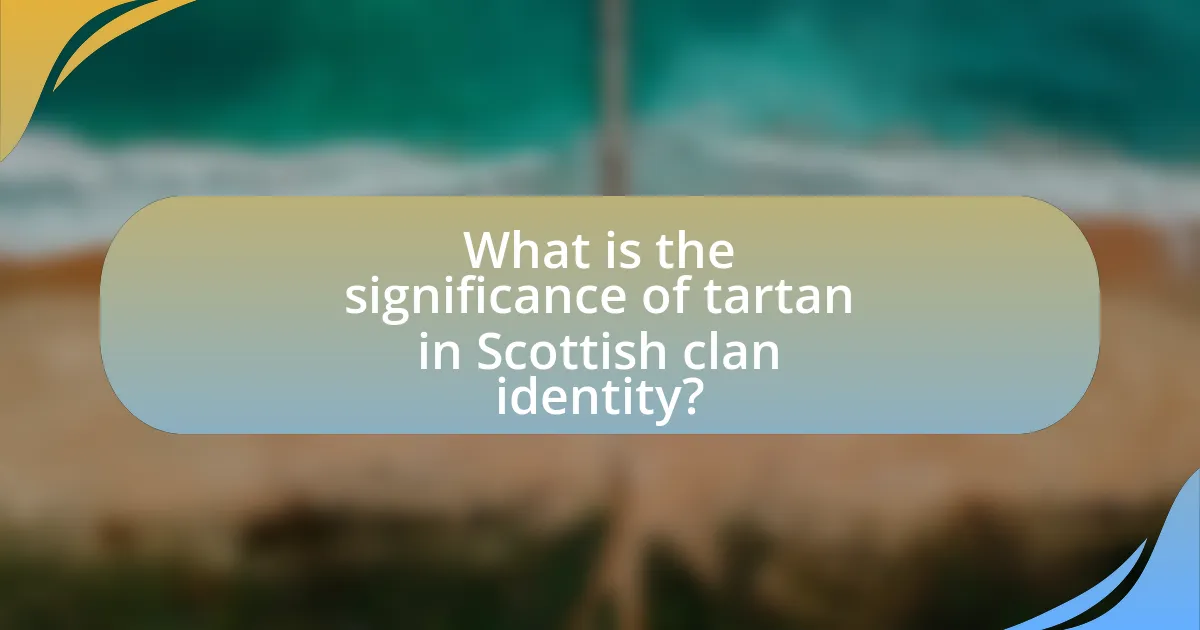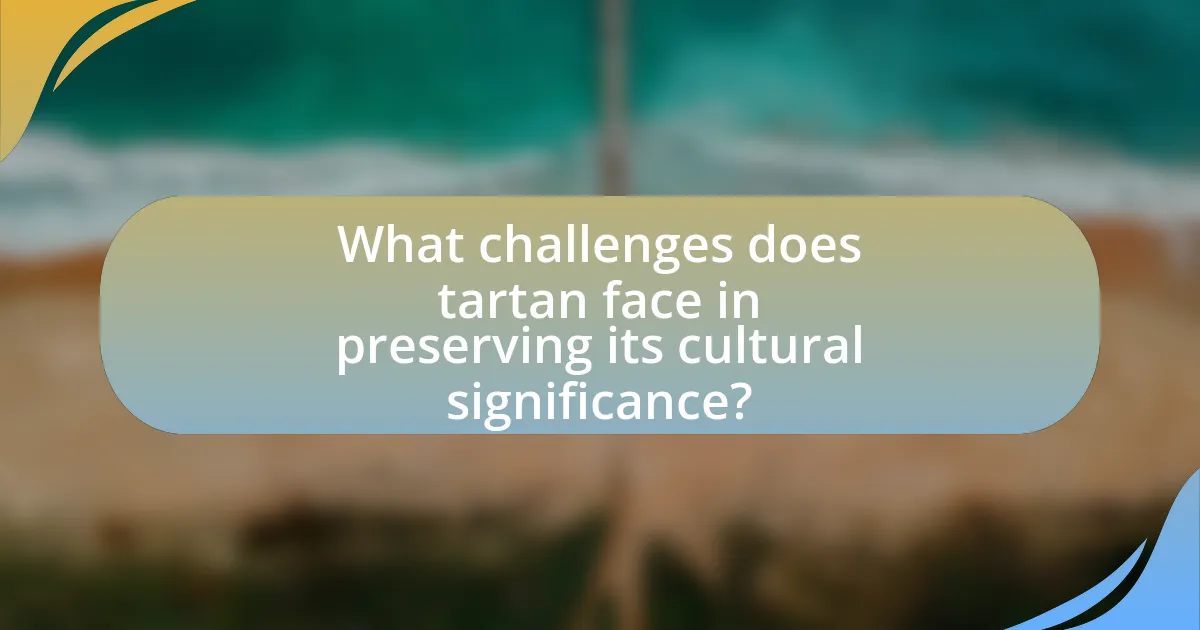Tartan plays a crucial role in Scottish clan identity, serving as a visual representation of heritage and unity. Each tartan pattern is uniquely associated with specific clans, symbolizing their history and values. The article explores the historical significance of tartan, its association with Scottish clans since the 16th century, and the impact of events like the Jacobite uprisings on its cultural importance. It also examines the different types of tartan, their meanings, and how they are used in contemporary Scottish culture, including fashion and festivals. Additionally, the challenges of preserving tartan’s cultural significance in a globalized market and the efforts to promote authentic tartan use are discussed.

What is the significance of tartan in Scottish clan identity?
Tartan is significant in Scottish clan identity as it serves as a visual representation of clan heritage and unity. Each tartan pattern is associated with a specific clan, symbolizing its history, values, and lineage. Historically, tartans were used to distinguish between different clans, with unique patterns developed over centuries. The use of tartan in clothing, particularly kilts, reinforces clan affiliation during cultural events and gatherings, fostering a sense of belonging among members. Additionally, the Scottish Tartan Act of 1815 formalized the recognition of tartans, further solidifying their importance in clan identity and heritage.
How did tartan become associated with Scottish clans?
Tartan became associated with Scottish clans primarily through its use as a distinctive pattern that represented specific clans and their identities. In the 16th century, tartan patterns began to be linked to particular Scottish clans, with each clan adopting unique designs that symbolized their heritage and lineage. The 19th century solidified this association when the Scottish tartan industry formalized clan patterns, leading to the establishment of the modern tartan registry. This registry documented various tartans, ensuring that each clan’s specific pattern was recognized and preserved, further embedding tartan into the cultural identity of Scottish clans.
What historical events contributed to the adoption of tartan by clans?
The adoption of tartan by clans was significantly influenced by the Jacobite uprisings of the 17th and 18th centuries. These uprisings, particularly the 1745 rebellion led by Charles Edward Stuart, fostered a sense of clan identity and unity among Scottish clans, leading to the widespread use of tartan as a symbol of loyalty and heritage. Following the defeat at the Battle of Culloden in 1746, the British government imposed the Dress Act, which banned the wearing of tartan and other Highland dress, further solidifying its association with Scottish identity and resistance. This ban led to a romanticized revival of tartan in the 19th century, as clans sought to reclaim their cultural heritage, culminating in the establishment of specific tartans for different clans, which became emblematic of clan identity.
How did the Jacobite uprisings influence tartan’s role in clan identity?
The Jacobite uprisings significantly elevated tartan’s role in clan identity by associating specific patterns with particular clans, thereby fostering a sense of unity and loyalty among clan members. During the uprisings, which occurred in the 18th century, tartan became a symbol of resistance against British rule, with clans adopting distinctive tartans to signify their allegiance. The 1745 uprising, led by Charles Edward Stuart, particularly popularized the use of tartan as a visible marker of clan identity, as many clansmen wore their tartans in battle, reinforcing their connection to their heritage. This association was further solidified by the subsequent ban on wearing tartan after the uprisings, which made it a symbol of defiance and pride for the Scottish clans.
What are the different types of tartan and their meanings?
Tartan types include clan tartans, district tartans, and fashion tartans, each serving distinct purposes and meanings. Clan tartans represent specific Scottish clans, symbolizing heritage and identity; for example, the MacLeod tartan signifies the MacLeod clan. District tartans are associated with geographical areas, such as the Campbell tartan, which reflects the region of Argyll. Fashion tartans, on the other hand, are created for commercial use and do not have clan affiliations, often used in contemporary clothing. The significance of these tartans lies in their ability to convey lineage, regional pride, and personal style, reinforcing the cultural identity of Scottish clans and communities.
How do clan tartans differ from district tartans?
Clan tartans are specific patterns associated with individual Scottish clans, representing their unique heritage and identity, while district tartans are designed to represent geographical areas rather than familial ties. Clan tartans often have historical significance tied to the clan’s lineage, with specific colors and patterns that reflect the clan’s history, while district tartans are more generalized and can be used by anyone from that area, lacking the same familial connection. For example, the MacDonald clan has a distinct tartan that symbolizes their lineage, whereas the tartan for the Highlands represents the broader region without specific ties to a single family.
What role do colors and patterns play in the symbolism of tartan?
Colors and patterns in tartan serve as vital symbols of Scottish clan identity, representing lineage, heritage, and social status. Each tartan design features specific color combinations and patterns that are unique to particular clans, allowing individuals to identify their ancestral ties. For instance, the MacLeod tartan is characterized by its distinctive yellow and black check pattern, which signifies the clan’s history and pride. Historically, these colors and patterns were used to convey messages about clan allegiance and unity, with different designs emerging over centuries to reflect the evolving identity of Scottish clans.
Why is tartan considered a symbol of Scottish heritage?
Tartan is considered a symbol of Scottish heritage because it represents the distinct identities of Scottish clans and their historical significance. Each tartan pattern is associated with a specific clan, reflecting its lineage, culture, and traditions. Historically, tartans were used to identify individuals and groups, particularly during the Jacobite uprisings in the 18th century, when they became emblematic of Scottish nationalism. The Scottish Tartan Act of 1815 further solidified tartan’s status by regulating its use and promoting its cultural importance. Thus, tartan serves as a visual representation of Scotland’s rich history and the pride of its people.
How does tartan reflect the cultural identity of Scotland?
Tartan reflects the cultural identity of Scotland by symbolizing clan heritage and regional pride. Each tartan pattern is associated with specific Scottish clans, representing their unique history and lineage. For example, the MacGregor tartan is linked to the MacGregor clan, which has a storied past in Scottish history. Additionally, tartan is used in various cultural expressions, such as traditional dress, music, and festivals, reinforcing its significance in Scottish identity. The Scottish Parliament recognized tartan as a national symbol in 2008, further solidifying its role in representing Scotland’s cultural heritage.
What impact does tartan have on modern Scottish nationalism?
Tartan significantly influences modern Scottish nationalism by serving as a symbol of cultural identity and heritage. The use of tartan in national events, such as the annual Edinburgh Tattoo and various Highland Games, reinforces a collective Scottish identity and pride. Additionally, the resurgence of interest in clan tartans since the late 20th century has fostered a sense of belonging among Scots, both in Scotland and the diaspora. This cultural revival is evidenced by the establishment of organizations like the Scottish Tartans Authority, which promotes the history and significance of tartan, further embedding it into the fabric of modern Scottish nationalism.

How is tartan used in contemporary Scottish culture?
Tartan is prominently used in contemporary Scottish culture as a symbol of national identity and heritage. It is featured in various forms, including clothing, accessories, and home decor, often representing specific clans or regions. For instance, tartan patterns are commonly worn during cultural events, such as Highland games and weddings, where individuals don kilts or sashes that reflect their clan affiliation. Additionally, tartan is utilized in modern fashion by designers who incorporate traditional patterns into contemporary garments, thereby bridging the gap between heritage and modernity. The Scottish government also promotes tartan as a cultural emblem, with the establishment of the Scottish Register of Tartans, which officially recognizes and preserves the diverse range of tartan designs, further solidifying its role in contemporary Scottish culture.
What are the modern applications of tartan in fashion and design?
Modern applications of tartan in fashion and design include clothing, accessories, and home decor. Designers frequently incorporate tartan patterns into contemporary garments, such as skirts, jackets, and scarves, reflecting both traditional Scottish heritage and modern aesthetics. High-profile fashion brands, including Burberry and Vivienne Westwood, have utilized tartan in their collections, showcasing its versatility and appeal. Additionally, tartan is used in interior design, appearing in upholstery, curtains, and rugs, which adds a classic yet stylish element to modern spaces. The enduring popularity of tartan in these areas highlights its significance in both cultural identity and contemporary fashion trends.
How do designers incorporate traditional tartan into contemporary clothing?
Designers incorporate traditional tartan into contemporary clothing by blending classic patterns with modern silhouettes and materials. This approach allows for the preservation of cultural heritage while appealing to current fashion trends. For instance, designers often use tartan in casual wear, such as shirts and skirts, and upscale garments, like tailored coats, to create a versatile aesthetic. The use of innovative fabrics, such as stretch blends, enhances comfort and wearability, making tartan suitable for everyday use. Additionally, collaborations with contemporary artists and brands have led to unique interpretations of tartan, further integrating it into modern wardrobes. This fusion not only honors the historical significance of tartan but also revitalizes its presence in fashion, ensuring its relevance in contemporary culture.
What role does tartan play in Scottish festivals and celebrations?
Tartan plays a central role in Scottish festivals and celebrations by symbolizing clan identity and heritage. During events such as the Highland Games and Burns Night, participants often wear tartan patterns that represent their specific clans, fostering a sense of belonging and pride. Historically, tartan has been associated with Scottish culture since at least the 16th century, and its use in festivals reinforces traditional customs and community ties. The vibrant display of various tartans during these celebrations not only showcases Scotland’s rich textile history but also serves as a visual representation of the diverse clans that contribute to Scotland’s cultural landscape.
How do clans use tartan to foster community and identity today?
Clans use tartan to foster community and identity today by creating a visual symbol that represents their heritage and unity. Tartan patterns are often associated with specific clans, allowing members to express their affiliation and pride during gatherings, ceremonies, and events. For instance, the wearing of clan tartan at events like Highland games or family reunions reinforces bonds among members and promotes a sense of belonging. Additionally, the resurgence of interest in genealogy and clan heritage has led to increased participation in clan societies, where tartan serves as a key identifier, further solidifying community ties.
What events celebrate clan tartans and their significance?
Clan tartans and their significance are celebrated during events such as Highland Games, clan gatherings, and Scottish festivals. Highland Games, held in various locations, feature traditional athletic competitions and cultural displays, emphasizing the importance of clan identity through tartan. Clan gatherings, often organized by specific clans, provide opportunities for members to wear their tartans, share heritage, and strengthen community ties. Additionally, Scottish festivals, like the Edinburgh Festival, showcase tartan through parades, music, and dance, highlighting its role in Scottish culture and identity. These events collectively reinforce the historical and cultural significance of clan tartans.
How do clans maintain their tartan heritage in the modern world?
Clans maintain their tartan heritage in the modern world through cultural events, educational initiatives, and the promotion of traditional attire. These clans organize gatherings such as Highland games and clan festivals, where members wear their tartans, reinforcing their identity and connection to heritage. Additionally, many clans engage in educational programs that teach younger generations about the history and significance of their tartans, ensuring that knowledge is passed down. The rise of online platforms also allows clans to share their tartan designs and stories globally, fostering a sense of community and pride among members. This multifaceted approach helps preserve the cultural significance of tartan within Scottish clan identity.

What challenges does tartan face in preserving its cultural significance?
Tartan faces several challenges in preserving its cultural significance, primarily due to commercialization, cultural appropriation, and the dilution of traditional meanings. Commercialization has led to mass production of tartan patterns, often disconnected from their historical and clan associations, which undermines their authenticity. Cultural appropriation occurs when non-Scottish entities adopt tartan without understanding its cultural context, further eroding its significance. Additionally, the increasing trend of blending tartan designs for fashion purposes can dilute the unique identities tied to specific clans, making it difficult for tartan to maintain its role as a symbol of Scottish heritage.
How has globalization affected the perception of tartan?
Globalization has broadened the perception of tartan, transforming it from a symbol of Scottish heritage to a global fashion statement. This shift is evidenced by the widespread use of tartan patterns in international fashion, home decor, and branding, which often detach the fabric from its cultural roots. The rise of global fashion brands incorporating tartan into their collections has led to a commodification of the pattern, making it accessible and desirable beyond Scotland. Additionally, events like the Edinburgh Festival and Highland Games attract international audiences, further popularizing tartan and reinforcing its status as a universal symbol of Scottish identity.
What are the risks of commercializing tartan?
The risks of commercializing tartan include the dilution of its cultural significance and the potential for misrepresentation of Scottish heritage. When tartan is mass-produced and sold without regard for its traditional meanings, it can lead to a loss of authenticity, as specific patterns are often tied to particular clans and histories. This commercialization can also result in unauthorized use of clan designs, which may offend those who hold these symbols sacred. Furthermore, the commodification of tartan can reduce it to a mere fashion statement, overshadowing its deep-rooted connections to Scottish identity and community.
How can clans protect their tartan heritage in a global market?
Clans can protect their tartan heritage in a global market by registering their tartans with the Scottish Register of Tartans, which provides legal recognition and helps prevent unauthorized use. This registration process, established in 2008, ensures that each tartan is documented and attributed to its respective clan, thereby safeguarding its cultural significance. Additionally, clans can engage in educational initiatives to raise awareness about the importance of their tartan heritage, promoting authenticity and discouraging counterfeit products. By collaborating with local artisans and manufacturers, clans can also support the production of genuine tartan goods, ensuring that their heritage is represented accurately in the marketplace.
What efforts are being made to promote authentic tartan use?
Efforts to promote authentic tartan use include initiatives by organizations such as the Scottish Tartans Authority, which works to preserve and promote the history and authenticity of tartan patterns. This organization provides resources for verifying tartan designs and educates the public about the significance of traditional tartans in Scottish culture. Additionally, events like the Tartan Day celebrations and various clan gatherings encourage the wearing of authentic tartans, fostering a sense of identity and heritage among Scottish clans. These efforts are supported by historical documentation and guidelines that ensure the integrity of tartan use, reinforcing its cultural importance.
How do organizations work to educate the public about tartan’s history?
Organizations educate the public about tartan’s history through various initiatives such as workshops, exhibitions, and educational programs. For instance, the Scottish Tartans Authority provides resources and conducts events that highlight the significance of tartan in Scottish culture and clan identity. Additionally, museums like the National Museum of Scotland feature displays that explain the evolution of tartan patterns and their historical context, helping visitors understand their cultural importance. These efforts are supported by historical documentation and research, which validate the role of tartan in representing Scottish heritage and clan affiliations.
What role do educational institutions play in preserving tartan culture?
Educational institutions play a crucial role in preserving tartan culture by integrating it into their curricula and promoting awareness through various programs. Schools and universities often offer courses on Scottish history, culture, and textiles, which include the study of tartan patterns and their significance to clan identity. For instance, institutions like the University of Edinburgh and the Scottish Borders College provide educational resources and workshops that explore the historical context and contemporary relevance of tartan. Additionally, educational institutions frequently host events such as tartan festivals and exhibitions, fostering community engagement and appreciation for this cultural heritage. These initiatives not only educate students but also encourage the broader public to recognize and celebrate the importance of tartan in Scottish identity.
What are some best practices for wearing and displaying tartan respectfully?
To wear and display tartan respectfully, individuals should first ensure they are using the correct tartan associated with their clan or heritage. This practice honors the historical significance of tartan patterns, which often represent specific Scottish clans and families. Additionally, wearing tartan in appropriate contexts, such as formal events or cultural celebrations, reinforces respect for its cultural importance. It is also advisable to avoid using tartan in commercial or trivial contexts that may undermine its significance, as tartan is deeply tied to Scottish identity and pride. Engaging with the history and meaning behind the tartan fosters a deeper appreciation and respectful display of this cultural symbol.




